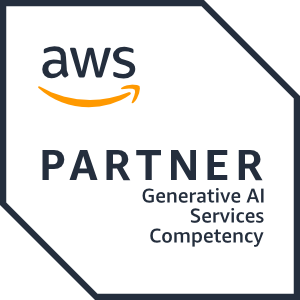- Support:+971 4 3364 840
- Email:[email protected]
- Locations:Dubai • Riyadh • Bangalore
Integra is a certified AWS Generative AI Competency partner, helping our customers adopt the best of GenAI to increase business productivity and stay ahead of the competition.

How can GenAI help you in your Software Development Lifecycle?
Automated Requirement Gathering: AI-powered chatbots analyze stakeholder conversations and generate requirement documents.
Risk Assessment: AI models predict potential risks in the project by analyzing past data and industry trends.
Enhanced Decision Making: AI suggests the best development methodologies (Agile, Waterfall, etc.) based on project complexity.
Automated Architecture Suggestions: AI recommends optimized system architectures based on previous successful designs.
Wireframing & Prototyping: AI tools generate UI/UX mockups based on text descriptions.
Code Blueprint Generation: AI creates initial code structures for microservices, APIs, and system flows.
AI-Powered Code Generation: AI assists developers by auto-generating functions, refactoring code, and reducing syntax errors.
Automated Code Reviews: AI checks code for errors, security vulnerabilities, and best practices.
Natural Language to Code: Developers describe functionality in plain English, and AI generates corresponding code.
Automated Test Case Generation: AI generates unit, integration, and functional test cases.
Self-Healing Tests: AI adapts test scripts automatically when UI changes occur.
Bug Prediction & Fixes: AI predicts defects before testing begins and suggests fixes.
Optimized CI/CD Pipelines: AI suggests the best deployment strategies and auto-tunes configurations.
Infrastructure as Code (IaC) Optimization: AI enhances Kubernetes and Terraform configurations for cloud deployments.
Predictive Failure Analysis: AI predicts potential deployment failures before they happen.
Automated Incident Resolution: AI suggests fixes for production issues using historical data.
Anomaly Detection: AI detects unusual behaviors in logs and performance metrics.
Performance Optimization: AI recommends scaling solutions to improve software performance.
At Integra, we’ve implemented GenAI in various facets of our development practice – and is experiencing the benefits firsthand. Integrating GenAI with our internal software teams has significantly accelerated our entire software development lifecycle. GenAI is effectively turning ideas into clear requirements, translating these requirements into user stories, creating test cases from user stories, generating code from test cases, and producing detailed documentation from the resulting code. Every stage has become quicker and more effective.
We have integrated JIRA Software, Confluence, ServiceDesk, GitLab, GitHub, BitBucket and many other tools and applications in the lifecycle to use GenAI to reduce time to market and increase productivity.
This early success reinforces our view that we’re only seeing the beginning of what GenAI can do. Soon, GenAI will automate or significantly enhance every aspect of software development—and it might even evolve beyond Agile methodologies as we currently understand them.
To understand what we have done internally, and how our contracted customers have benefited from this, please get in touch.

What is Generative AI (GenAI)?
Generative AI is a type of AI that can create new content and ideas, including conversations, stories, images, videos, and music. Like all AI, generative AI is powered by ML models—very large models that are pre-trained on vast amounts of data and commonly referred to as foundation models (FMs). Recent advancements in ML (specifically the invention of the transformer-based neural network architecture) have led to the rise of models that contain billions of parameters or variables. FMs can perform so many more tasks because they contain many parameters that make them capable of learning complex concepts.
The size and general-purpose nature of FMs make them different from traditional ML models, which typically perform specific tasks, like analyzing text for sentiment, classifying images, and forecasting trends.
To achieve each task, for each ML model, customers need to gather labeled data, train a model, and deploy that model. With foundation models, instead of gathering labeled data and training multiple models, you use the same pretrained FM to adapt several tasks. FMs can also be customized to perform domain-specific functions that are differentiating to their businesses, using only a small fraction of the data and compute required to train a model from scratch.
There are three reasons that explain foundational models’ success:
The transformer architecture: The transformer architecture is a type of neural network that is efficient, easy to scale, and parallelize, and can model interdependence between input and output data.
In-context learning: Showing potential on a range of applications, from text classification to translation and summarization, this new training paradigm provides pre-trained models with instructions for new tasks or just a few examples instead of training or fine-tuning models on labeled data. Because no additional data or training is needed and prompts are provided in natural language, models can be applied right out of the box
Emergent behaviors at scale: Growing model size and the use of increasingly large amounts of data have resulted in what is being termed as “emerging capabilities.” When models reach a critical size, they begin displaying capabilities not previously present.
Case Studies

Diglossia Middle East
Read how Integra helped Diglossia with AWS Generative AI solutions which helped improve student outcomes and measures literacy progress over time.

Data Inflexion
Read how Integra helped Data Inflexion, a startup specializing in creating libraries and tools for real estate and property listing website developers.